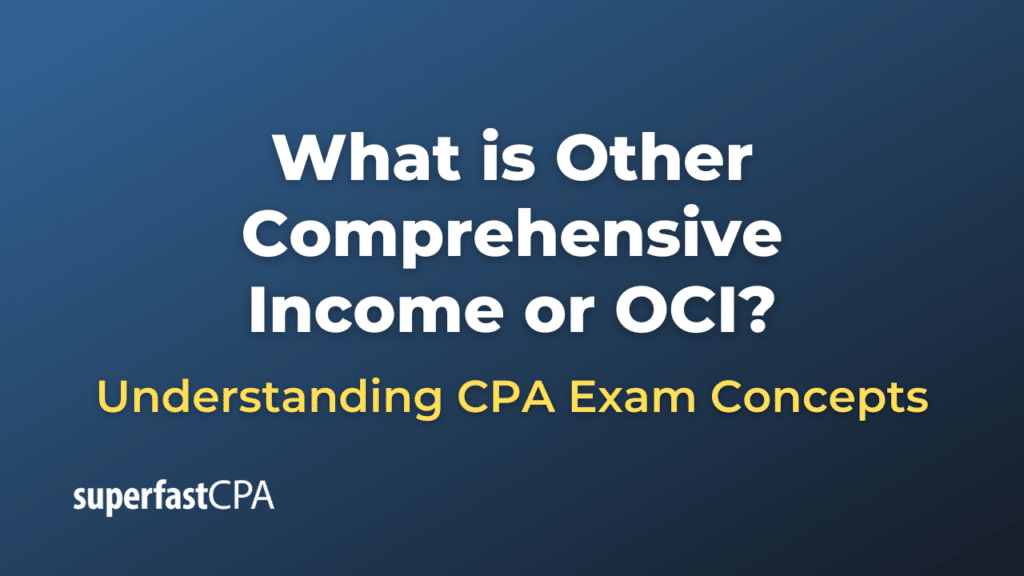Introduction to Other Comprehensive Income (OCI)
Definition of Other Comprehensive Income
In this article, we’ll cover what is other comprehensive income or OCI. Other Comprehensive Income (OCI) represents certain gains and losses that have not been realized and are excluded from net income on the income statement. It includes items that are typically not part of the regular operations of a business and therefore not included in the net income figure. OCI items are recorded directly in a company’s equity section of the balance sheet under the accumulated other comprehensive income line item. This accounting method allows for a clearer distinction between the results of regular operating activities and other elements that may significantly influence the financial position of a company without affecting its cash flow or net income immediately.
Brief Overview of Its Purpose and Importance in Financial Reporting
The primary purpose of OCI is to provide a more comprehensive view of a company’s financial performance and health beyond what the net income figure reveals. Since net income is often the focus of financial analysis and decision-making, it can sometimes give an incomplete picture of a company’s financial status. OCI comes into play to fill this gap by including income and expense items that have not yet been realized. These items might include changes in the fair value of investments, foreign currency translation adjustments, and unrealized gains or losses on certain types of hedges.
Including OCI in financial reporting is important because it allows investors, analysts, and other stakeholders to see a fuller picture of a company’s total comprehensive income. This visibility helps in assessing the company’s financial health more accurately. For instance, significant amounts in OCI can indicate potential future impacts on the income statement, offering insights into risks and opportunities that the company faces. In essence, OCI enhances transparency in financial reporting, providing a more detailed and nuanced view of a company’s financial outcomes and equity changes over a period.
Components of OCI
Listing and Explanation of Typical Items Included in OCI
Other Comprehensive Income (OCI) encompasses a range of items that are not included in the net income but are essential for understanding a company’s overall financial performance. Here are some of the typical components of OCI:
- Unrealized Gains and Losses on Available-for-Sale Securities: These are changes in the fair value of securities that a company holds but does not intend to sell immediately. These securities are classified as available-for-sale (AFS), and any unrealized gains or losses (i.e., changes in market value that have not yet been realized through a sale) are reported in OCI. The rationale is that these changes are temporary and could reverse in the future, so they are not included in net income until the securities are actually sold.
- Foreign Currency Translation Adjustments: These adjustments arise when a company has operations in foreign countries, and it needs to convert the financial statements of these operations into the company’s reporting currency. The fluctuations in exchange rates between the foreign currency and the reporting currency can lead to gains or losses, which are reflected in OCI. This ensures that the company’s financial statements reflect the potential impact of exchange rate movements on its equity, without affecting the net income until these gains or losses are realized upon the actual conversion or settlement of the foreign currency balances.
- Unrealized Gains and Losses on Derivative Instruments: Companies often use derivatives (like futures, options, and swaps) for hedging purposes to manage risk. The unrealized gains or losses on these instruments, resulting from changes in market conditions, are recorded in OCI. This accounting treatment is particularly relevant for derivatives designated in cash flow hedging relationships, where the effective portion of the gain or loss on the derivative is reported in OCI until the forecasted transaction affects net income.
- Pension Plan Gains and Losses: These are changes in the projected benefit obligation and plan assets of a company’s pension plan, which can result from differences between the actual and expected performance of plan assets or changes in actuarial assumptions. These gains and losses are recognized in OCI because they represent long-term adjustments to the pension costs that will be recognized in the income statement over time, reflecting the company’s obligation to its employees’ pension benefits in a more gradual manner.
By accounting for these items in OCI, companies can present a more accurate and complete picture of their financial status and performance, separating the effects of short-term market fluctuations and other temporary changes from their regular earnings results. This separation aids stakeholders in making more informed decisions based on both the current earnings and potential future impacts on the company’s finances.













